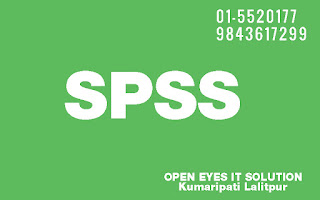 |
| SPSS training in Open Eyes |
Measurements incorporated into the base programming:
Elucidating measurements: Cross arrangement, Frequencies, Descriptives, Explore, Descriptive Ratio Statistics
Bivariate measurements: Means, t-test, ANOVA, Correlation (bivariate, fractional, separations), Nonparametric tests
Expectation for numerical results: Linear relapse
Expectation for recognizing bunches: Factor investigation, group examination (two-stage, K-implies, various leveled), Discriminant
 |
| SPSS |
The numerous components of SPSS Statistics are available through draw down menus or can be modified with a restrictive 4GL order linguistic structure dialect. Summon language structure programming has the advantages of reproducibility, disentangling monotonous undertakings, and taking care of complex information controls and investigations. Furthermore, some perplexing applications must be customized in punctuation and are not available through the menu structure. The draw down menu interface likewise creates summon language structure: this can be shown in the yield, in spite of the fact that the default settings must be changed to make the grammar unmistakable to the client. They can likewise be glued into a grammar document utilizing the "glue" catch present in every menu. Projects can be run intelligently or unattended, utilizing the supplied Production Job Facility.
Moreover a "full scale" dialect can be utilized to compose summon dialect subroutines. A Python programmability expansion can get to the data in the information word reference and information and powerfully form order linguistic structure programs. The Python programmability augmentation, presented in SPSS 14, supplanted the less useful SAX Basic "scripts" for most purposes, despite the fact that SaxBasic stays accessible. What's more, the Python expansion permits SPSS to run any of the insights in the free programming bundle R. From rendition 14 onwards, SPSS can be driven remotely by a Python or a VB.NET program utilizing supplied "modules". (From Version 20 onwards, these two scripting offices, and numerous scripts, are incorporated on the establishment media and are regularly introduced as a matter of course.)
SPSS Statistics places requirements on inner document structure, information sorts, information handling, and coordinating records, which together impressively rearrange programming. SPSS datasets have a two-dimensional table structure, where the lines normally speak to cases, (for example, people or family units) and the segments speak to estimations, (for example, age, sex, or family pay). Just two information sorts are characterized: numeric and content (or "string"). All information preparing happens successively case-by-case through the record. Documents can be coordinated balanced and one-to-numerous, however relatively few to-numerous.
The graphical client interface has two perspectives which can be flipped by tapping on one of the two tabs in the base left of the SPSS Statistics window. The 'Information View' demonstrates a spreadsheet perspective of the cases (lines) and variables (sections). Not at all like spreadsheets, the information cells can just contain numbers or content, and recipes can't be put away in these cells. The 'Variable View' shows the metadata word reference where every column speaks to a variable and demonstrates the variable name, variable name, esteem label(s), print width, estimation sort, and an assortment of different attributes. Cells in both perspectives can be physically altered, characterizing the document structure and permitting information passage without utilizing order sentence structure. This might be adequate for little datasets. Bigger datasets, for example, factual overviews are all the more regularly made in information section programming, or entered amid PC helped individual meeting, by filtering and utilizing optical character acknowledgment and optical imprint acknowledgment programming, or by direct catch from online surveys. These datasets are then perused into SPSS.
SPSS Statistics can read and compose information from ASCII content documents (counting various leveled records), different insights bundles, spreadsheets and databases. SPSS Statistics can read and keep in touch with outer social database tables by means of ODBC and SQL.
Factual yield is to an exclusive record design (*.spv document, supporting turn tables) for which, notwithstanding the in-bundle viewer, a stand-alone peruser can be downloaded. The restrictive yield can be sent out to message or Microsoft Word, PDF, Excel, and different configurations. On the other hand, yield can be caught as information (utilizing the OMS order), as content, tab-delimited content, PDF, XLS, HTML, XML, SPSS dataset or an assortment of realistic picture groups (JPEG, PNG, BMP and EMF).
The SPSS logo utilized before the renaming as a part of January 2010.
SPSS Statistics Server is an adaptation of SPSS Statistics with a customer/server engineering. It had a few elements not accessible in the desktop variant, for example, scoring capacities. (Scoring capacities are incorporated into the desktop form from adaptation.
No comments:
Post a Comment